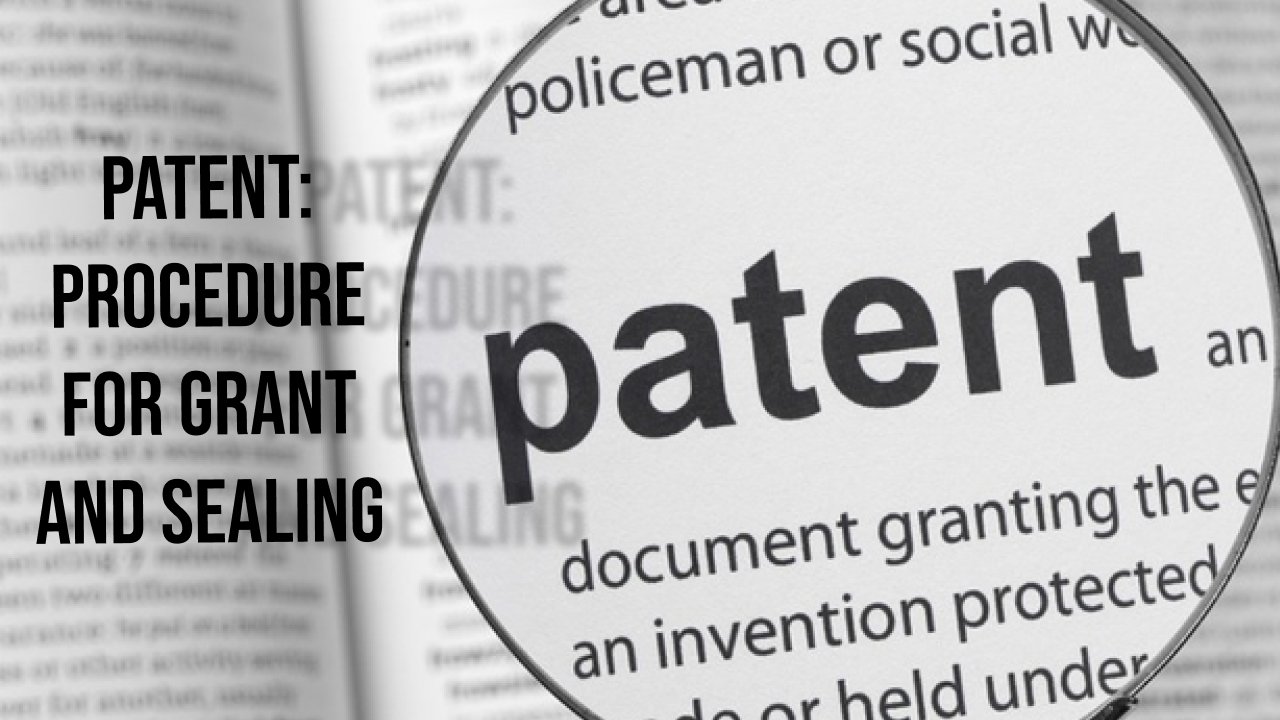PATENT: PROCEDURE FOR GRANT AND SEALING
This article provides an overview of the patenting process in India, exploring its historical evolution from the 1856 patent act to the comprehensive Indian Patents Act of 1970. It delves into the three key tests of patentability—novelty, utility, and inventiveness—emphasizing their significance in patent law, particularly in the landmark case of Novartis AG v. Union of India. The distinction between process patents and product patents is outlined, shedding light on their respective scopes and applications, with a focus on preventing monopolies in certain industries.

INTRODUCTION:
In general, a patent means “exclusive rights” granted to the true inventor as mentioned under sec 2(1)(m). Patents are rights given for an invention which is defined under Sec 2(1)(j) of the Indian Patents Act, 1970. "invention" means a new product or process involving an inventive step and capable of industrial application.
In India, the patent act can be traced back to 1856. Comprehensive legislation on patents was enacted by the British in the year 1911 in the form of the Indian Patents and Designs Act, 1911. After independence, various reports were published and final legislation was passed in the year 1970 which came to be known as the Indian Patents Act, 1970.
PATENTABILITY:
There are 3 tests of patentability.
- Novelty
- Utility
- Inventiveness
These were defined as essential features for invention in the case of Novartis AG v. Union of India.
PROCESS PATENT V. PRODUCT PATENT:
A product patent is granted to protect the original rights of a product and provides higher protection to the inventor whereas a process patent protects a process by which a product is being manufactured. The process patent is generally given for food and pharmaceuticals to prevent monopoly.
PROCEDURE FOR GRANT OF PATENTS:
It includes 5 steps:
- Submission of application for a patent-
The person claiming rights for his invention must submit an application for the same.
An application can be made for one invention only.
The applicant will give the name of the true and first inventor along with the specification of the invention (nature of invention). A specification can be provisional and complete but in the case of provisional specification, a complete specification must be submitted within the next 12 months.
Priority Date- the date of filing of the complete specification of the invention claimed by the person for a patent
- Examination of application-
Examiner will examine the application referred to him by the controller under sec 12.
Under the Patents Act, 1970, a request needs to be submitted for the examination process
failing which the application is considered withdrawn by the applicant. The
examination of the patent can be requested in a prescribed manner by:
- the applicant; or
- any other interested person.
The report made by the examiner to the Controller after referring to the application,
specifications and other documents related to the invention for which the patent is
being
sought and taking into account the considerations prescribed under Section 12(1) is
known as the First Examination Report (FER). The objections made by the examiner
should be conveyed to the applicant in the FER.
At last, the examiner will search for the anticipation in the patent to prove the novelty
and originality of the invention.
- Acceptance of an application for a patent-
After the examination process, objections will be taken into consideration. If no objection is raised within three months after acceptance of the application, then, the patent will be granted upon submission of the required fee. The patent once granted will last for twenty years.
- Opposition to grant of a patent-
Opposition can be made pre or post-grant.
- Pre Grant-Opposition: it can be made under section 11A of the Patents Act, 1970 within six months from the date of publication of the application.
- Post Grant Opposition: any person can file an application within 12 months of the publication of the grant of patent in the official journal of the patent office.
Grounds for opposition:
- Patent wrongfully obtained.
- Prior publication;
- The invention was publicly known or publicly used in India before the priority date of that claim.
- The invention is obvious and does not involve any inventive step;
- That the subject of any claim is not an invention within the meaning of this Act, or is not patentable under this Act; • Insufficient disclosure of the invention or the method by which it is to be performed;
- That in the case of a patent granted on a convention application, the application for the patent was not made within twelve months from the date of the first application for protection for the invention made in a convention country or in India;
- That the complete specification does not disclose or wrongly mentions the source and geographical origin of biological material used for the invention; and
- That the invention was anticipated having regard to the knowledge, oral or otherwise, available within any local or indigenous community in India or elsewhere.
- Grant and sealing of patents:
When an application for a patent has been found to be in order for grant of patent and is approved by the Controller. The application has not been found in contravention of any provision of this act.
INFRINGEMENT:
Patent Infringement occurs when someone makes, uses or sells a product which is covered by a patent. One of the main benefits of a patent is the ability to exclude others. A patent gives the owner the right to stop someone from infringing their patent rights. The law is a balance between encouraging an inventor to invent and allowing society to grow.
As per the provisions mentioned in the Indian Patents Act, 1970; the following amount as an act of Patent Infringement:
1. The colourable imitation of the invention
2. Mechanical Equivalents
3. Carrying essential features of the invention
4. Immaterial variation in the invention












